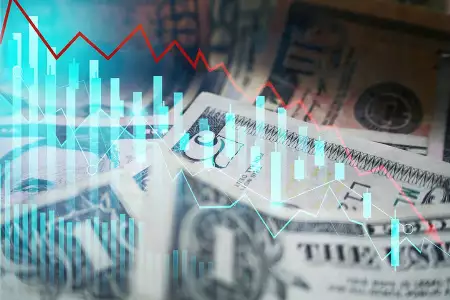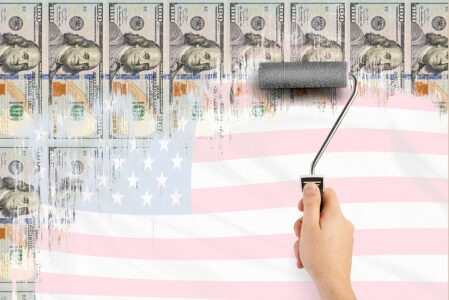February 21, 2022 Updated October 22, 2023
12
1 votes
Reading time: 1 minutes
The firm's main research and development office is based in Tel Aviv Israel. It originally specialized in Forex and indices spreadbetting and CFDs but has recently expanded in stock trading also.

A sizeable daily drop in a stock market index, such as the S&P 500 or FTSE 100, can feel like a big deal. However, daily stock market fluctuations should be expected. Sometimes a significant drop from the peak is necessary. This is what’s called a market correction.
Significant but temporary drops in the stock market are relatively common. A drop like this is called a market correction. Let’s take a look at what makes a market correction. We will also consider avoiding some of the pitfalls that investors can run into during a correction.
At the time of writing, eToro has 2.2 out of 5 star on Trust pilot. The comments suggest that the platform offers some impressive features but withdrawing money can be difficult. Having said that, some of the negative reviews appear to be rants rather than constructive criticism. This can be examples of traders losing money through their own recklessness rather than eToro's fault. You should therefore take this reviews with a pinch of salt. OANDA is a global financial services company providing advanced currency solutions to both retail and corporate clients all over the world. In this article, we are going to review this broker’s trading options, tools, platforms, spreads, commissions, security measures, and educational resources to help traders make the right choice. AvaTrade offers a wide variety of trading solutions (spread trading, CFDs, and social trading), and peace of mind with its comprehensive regulation, covering the EU, Australia, Canada and South Africa. Clients can use a variety of platforms for discretionary and automated trading.![]() Best Award Winning Brokers
Best Award Winning Brokers Show Search Filters
Show Search Filters
76% of retail investor accounts lose money when trading CFDs with this provider.
76.6% of retail investor accounts lose money when trading CFDs with this provider. You should consider whether you understand how CFDs work and whether you can afford to take the high risk of losing
76% of retail investor accounts lose money when trading CFDs with this provider.
According to Forbes, experts usually agree that a market correction has occurred when an asset or asset class drops between 10% and 20% in value from a recent high. A correction can apply to almost anything, including stock market indices, an individual stock, or other assets. In addition, corrections can occur in commodities, bonds, and currencies (including cryptocurrencies).
When looking at a stock market correction overall, it can make sense to consider a broad-based market index, such as the FTSE 100 or the S&P 500.
Market corrections are as old as the markets. In general, though, any decline in a market, index, or individual stock is caused by more sellers than buyers. When more people want to get rid of their investments than buy, prices drop.
The Corporate Finance Institute (CFI) points out that the term market correction helps differentiate between a bear market and a healthy pullback. Often, a market correction allows overvalued stocks to correct themselves before a trend continues higher.
When considering whether the market is experiencing a correction or moving into bear market territory, it’s essential to look at the size of the decline and the duration of the decline.
First of all, a bear market is a decline of more than 20% in value. Next, it’s important to look at how long the decline lasts. For the most part, Forbes points out, a technical correction is short-lived, while the last few bear markets have lasted an average of between 14 and 16 months.
Finally, a correction a degree of investor optimism marks. The assumption is that once the pullback is over, the upward trend will continue in a relatively short amount of time. With a bear market, the assumption is that the downward trend is likely to continue for several months or could stretch out to years.

Market corrections are relatively common. For example, a Schwab report points out 11 market corrections from 2000 to 2019. However, overall, only five years saw negative returns for the stock market — and these years encompassed the dot-com bust and the Great Recession.
Other experts from Forbes and CFI have pointed out that there have been about 27 stock market corrections for the S&P 500 since World War II, but only 12 bear markets.
A correction can lead to a bear market, but it’s not especially common to see a market correction turn into a bear market.
Different reasons might trigger a market correction. However, some of the common causes of a stock market correction include:
While we often think of market corrections in terms of the stock market, other asset classes can experience corrections. However, corrections are more likely to occur in assets with higher volatility. So let’s examine the volatility of a few asset classes.
Equities represent one of the most volatile asset classes. Stock prices go up and down regularly. As the Schwab report points out, it’s pretty standard for prices to swing significantly from day to day, even if the trend heads higher over time.
Because equities can be so volatile, trading them can be risky, especially if you’re involved with day trading. As a result, equities are prone to a market correction of 10% or more, with such drops occurring every few years.
On the other hand, bonds are considered less risky, and corrections are much less common with these assets. However, it’s still possible for a bond market correction. This is more likely to occur when interest rate expectations change and concerns about the future.
The foreign exchange market is relatively stable, but this isn’t always the case. For example, there are times like the CHF/EUR crash in January 2015. At this time, the Swiss National Bank announced that it was unpegging its franc from the euro. This caused a rapid decline in the Swiss franc, while the EUR/CHF pair gained quickly. However, one of the biggest crashes came in the USD/CHF pair. Even though the situation took place between the Swiss franc and the euro, the USD/CHF pair saw a considerable correction.
Some commodities are more volatile than others, so it’s important to pay attention to their prices and trends if you’re looking for evidence of correction. For example, oil prices can be especially volatile if issues like pipeline disruptions due to natural disasters or other problems. Additionally, oil saw a considerable drop in March 2020 when OPEC countries failed to reach a deal, resulting in concerns about a price war.
Additionally, commodities saw a correction during 2011, after news broke that the recovery from the Great Recession was not going well.
As a new asset class, cryptocurrencies are perhaps the most volatile of all. It is very common to see wide swings of 5% to 10% in price on various cryptocurrencies. In some cases, even popular and more established cryptocurrencies like Bitcoin have seen more than 50% corrections in a day. What keeps these large drops from being considered bear markets is that the corrections to the cryptocurrency market overall have so far been short-lived.
Market corrections can be caused by various factors, from trends gathering steam to a significant economic or political event sparking an emotional response from investors. Here are some examples of how some important events led to significant market corrections.

Economic and business factors can be a major cause of a stock market correction. For example, in March 2020, concerns about Covid-19 shutdowns across various countries and worldwide led to worries about an economic slowdown and business losses.
According to a paper from the National Institutes, over four days, the Dow Jones Industrial Average dropped 6,400 points or roughly 26%. Additionally, the analysis found that specific sectors struggled more than others when looking at individual stocks. Expectations of reduced travel and vehicle use, for example, led to 60% drops for companies involved with the crude petroleum sector.
However, the correction never turned into a bear market because the recovery was rapid. The S&P 500 returned to its pre-pandemic high within six months, and a year later was up 75% from its recent bottom.
Significant geopolitical risk events can also impact a market and cause a correction. Oil saw a correction in 2020 when OPEC countries could not agree. However, the oil shock of the early 1970s caused a decline in stock market prices. When an oil producer embargo on exports to the United States, the stock market reacted negatively as oil prices rose.
Research also indicates that oil shocks related to geopolitical events are more likely to impact the stock market. However, even though the oil embargo in response to the Yom Kippur War resulted in a correction for the stock market, the S&P 500 went up in the following years, and the S&P 500 ended the 1970s higher than its bottom, reached in 1974.
In 2013, when the United States Federal Reserve suggested tapering its asset purchase program, it caused a drop in emerging markets. As a result, futures valuations were downgraded and emerging markets saw a huge drop in their bond indices. A spike in Treasury yields was also part of the taper tantrum. Because Treasury yields move inversely to prices, that means a big drop in Treasury prices accompanied the so-called taper tantrum.
Interestingly, though, the taper tantrum did not significantly impact stock prices.
In general, even after these major events trigger a market correction, the market in question generally recovers in a relatively short period of time.
The stock market recovery following the March 2020 correction was relatively fast. It took six years for the S&P 500 to recover from its low during the Great Recession. It took less than a year following the correction of March 2020. The events of 2008 triggered a recession. However, the pandemic correction was just that — a correction that was overcome.
Likewise, even though the oil shock of 1973-1974 resulted in high inflation and other economic issues that plagued the rest of the 1970s and were not brought under control until the early 1980s, the S&P 500 still saw gains after the initial drop in prices.
Even though Treasury yields spiked (and prices fell) following the taper tantrum of 2013, yields began falling again (and prices rising) almost immediately. A year after yields reached a level above 3%, they fell toward 2%.
Because the main characteristic of a market correction is that it’s a temporary state of affairs, it’s relatively common to see the impacted assets recover pretty quickly.
While there’s no sure way to spot a coming market correction, there are some signs you can look for to see if a market correction might be on the way.
Based on the options prices of the S&P 500 index, the VIX measures the expectation of volatility in the next 30 days. This measure is sometimes called the “fear index,” and indicates investors are worried.
A spike in the VIX could indicate that problems could be coming and that a stock market drop is in the offing. For example, the VIX spiked in early 2020, ahead of the pandemic correction in March. However, the spike occurred in January, more than 30 days ahead of the March correction. So, while the VIX can provide you with insight that a correction could be coming, it does not indicate a time frame.
By reviewing the volumes in the options market, it’s possible to get an idea of bullish risk-taking. High volumes could indicate that a lot of traders are engaged in risky trades. As volumes rise quickly, it could also mean that there’s room for a market correction. When a market becomes overheated, especially in a short period, a correction is often on its way as a method of bringing asset prices in line. A lot of risk-taking usually ends as a decline follows a peak.
Another indication that a market correction could be when cash levels are nearing all-time lows — or even reaching them. In some cases, this could signify that investors will soon get ready to liquidate some positions, freeing up their cash. But, again, as investors sell, this could result in a correction.
However, it is important to be careful when evaluating cash levels for a sign of an impending correction. In some cases, it could mean that investors are happy to have their money in the market working for them and that they aren’t quite ready for a market correction.
It can be difficult to “catch a falling knife” when trying to time a market correction and profit. So rather than trying to figure out when the bottom arrives or try to make decisions in the moment, there are some things you can do to position your portfolio to benefit from market corrections.
Consistency over time can help you grow your wealth in the long run. First, figure out how much you can invest each week or month. Then, put that same amount into investments, regardless of what’s happening in the markets.
For example, if you decide you can put in 150 pounds per week, you do that automatically and buy shares automatically. Then, when a market correction is in process and prices decline, the money you’re already putting in will buy more of the asset. Later, when the correction is over and the prices rise, you benefit from having bought more.
Perhaps you have extra cash that you want to deploy during a market correction. Before a correction takes place, have a plan. You can choose a level that makes sense to you. Perhaps you decide to buy when an index or asset loses 10% of its value or 20% of its value. Deploy your cash and buy shares when the asset or index reaches that threshold.
Instead of waiting for a potential bottom, you still get a “discounted” price, and you can benefit when the prices recover, seeing a bigger appreciation.
Have a plan to regularly buy quality assets. Rather than trying to jump on the latest fad or take advantage of a correction, you can know that purchasing value investments will help you gain in the long run. Quality assets are likely to weather a downturn, and if you are consistent with pound cost averaging and using extra cash to buy additional shares when a quality company or asset is “on sale,” you will be more likely to make money over time.
This final strategy is not for the faint of heart. It is higher risk and can come with more work and time involvement. According to anecdotal evidence, the idea is that you can buy 30 minutes before market close on Friday afternoons in an attempt to catch deals as traders dump their positions to avoid holding them over the weekend. However, this is a risky strategy that can backfire, so it’s important to be wary of using it.
When you attempt to invest during a market correction, you need to be aware of the risks involved. Any time you invest or trade, you run the risk of losing your principal. It’s important to carefully consider any strategy or asset.
Here are some of the things to be aware of when you invest during a market correction.
In some cases, what begins as a small sell-off could become more serious. Black Monday, which took place in October of 1987, was such a case. Around the world stock markets began with small sell-offs that eventually became huge. In the end, the Dow Jones Industrial Average dropped 22.6% in a single trading session.
When something turns into such a big loss, it can be tempting to sell instead of buy low. This can lock in losses. In the end, the Black Monday losses were recovered relatively quickly. About 57% of the downturn’s losses recovered in two trading sessions. However, those who panicked when they saw such a big loss ended up losing out. They also didn’t benefit from the turnaround.
The idea of “buying the dip” has been popular for a while. However, what happens if the correction lasts longer than you expect — or turns into a bear market. In 1929, some investors kept buying more, expecting things to turn around. However, that crash led to the Great Depression.
It’s important to be prepared for the possibility of a longer downturn, bear market, or depression. You might need to keep your money locked up for longer than expected if buying the dip doesn’t provide you with a fast way to earn money through trading.
Another issue is that brokers can struggle to fill orders when everyone is trying to trade at the same time. Some platforms might not be able to keep up with the demand. You might not be able to access your account. This happened to eToro in February 2021.
Additionally, other brokers and clearinghouses sometimes stop trading when an asset is heavily traded. For example, at the height of the GameStop frenzy, many brokers and clearinghouses restricted trading on that stock.
There are also market circuit breakers in some cases that are triggered by widespread losses, especially in the U.S. stock market. When this happens, you might not be able to trade or access your account.
Market corrections are fairly common and a regular part of the economic cycle. In general, especially if you invest in stocks, you can expect a market correction to occur on a regular basis. However, corrections are usually relatively short in duration and the market often recovers quickly afterward. As a result, it’s important to carefully consider your strategy and avoid making big changes in response to a correction.







